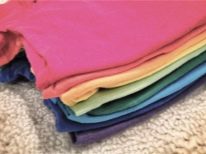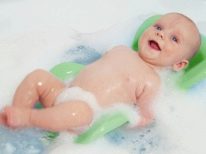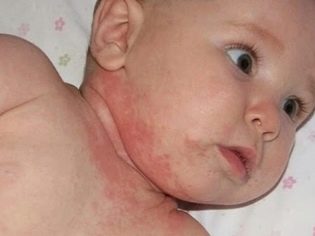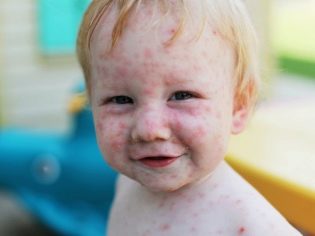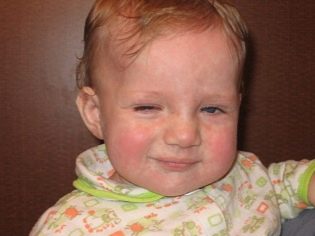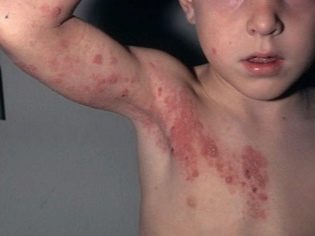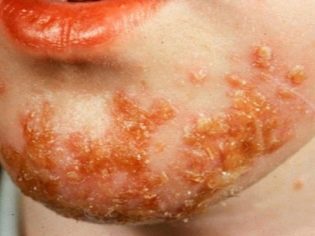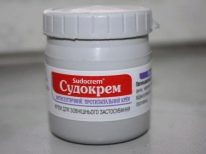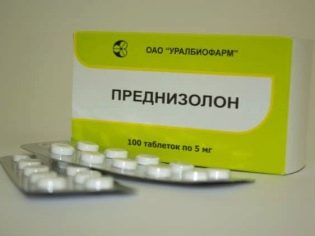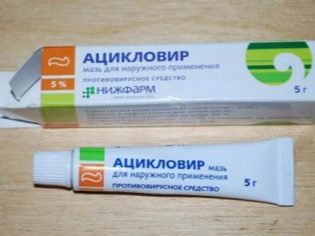What to do if there is a rash on the body of a child?
All parents know that a rash on the body of a child is a danger signal. And indeed, many infectious diseases are accompanied by skin rashes in different parts of the body. How to understand what happened to the baby, how dangerous it is and what to do, we will tell in this article.
What is a rash?
In order to understand the causes of a rash on a baby’s body, there are many factors to consider: the child’s age, living conditions, and hygienic care, as a rash on the body doesn’t always mean a disease.
Therefore, all skin rashes can be divided into:
- infectious (caused by viruses, bacteria, fungi);
- non-infectious (caused by external factors not related to diseases).
It is rather difficult to distinguish one from the other; it is necessary to take into account additional symptoms.
The rash itself is also a bulky concept. It may look like red or pink specks, colorless or red bumps, blisters with liquid contents, abscesses, pink spots with peeling fragments.
The rash may be surrounded by inflamed tissue, erythema. On examination of the child, the mother also needs to note whether the rashes are single or tend to merge with each other, unite into larger lesions. Rashes on the skin of a child can appear suddenly, in the complete absence of other signs of a possible disease, and can complement the picture of an existing disease. So, with a certain type of sore throat, a herpetic rash may appear on the body.
Special features
Many mothers of babies noticed that the crumbs of rash may appear suddenly. Equally unexpected, it may disappear. Indeed, the readiness of the skin to react to internal and external stimuli in childhood is great. This is due to the fact that the skin of children is much thinner than the skin of adults, it is more saturated with moisture, it feeds better on blood.
Due to the permeability of the blood vessels in the child, scratches and wounds heal faster, but various lesions of the epidermis and deeper layers of the skin also appear much faster and easier.
For children's skin health There is nothing insignificant. Both dry air in the room, and too aggressive soap that bathes the baby, and synthetic clothing, and even children with food allergens, most often respond to skin eruptions can play a role.
Children's immunity is imperfect. In the first six months of the child’s life, to some extent protects the maternal innate immunity, but after this age any viral or bacterial disease becomes more than likely. This does not mean that up to six months, babies do not have an infectious rash. Maternal immunity is also not an absolute guarantee of protection.
Own immunity, including local skin immunity, develops gradually, as far as “familiarity” with certain pathogens of diseases. Well, if this acquaintance takes place in the treatment room, where the child is vaccinated against the most dangerous infections. Otherwise, the immunity is trained "in combat conditions" during the illness.
Due to weak immunity, vulnerable thin skin, rash in children is a frequent phenomenon. Not every eruption is a disease, but it is important to be prepared for a negative turn of events.
What to do when detected?
If you woke up and saw that the child's body was covered with a rash, you should carefully examine the skin, assess the size, distribution and location of the rash, note the presence or absence of pustules, wheals.
Next, proceed to assess the overall health of the baby. They measure body temperature, inspect the tonsils, check if the nose is breathing, and if the throat is sore.
If painful symptoms are found, then should immediately call a doctor at home. Going with the child to the clinic is irresponsible, because the majority of infections that start in this way are highly infectious, and children who may become infected will be in the queue to the pediatrician
If the child is not a year old, and in addition to the rash, his temperature is above 39.0 degrees, an Ambulance should be called without reasoning.
If no painful symptoms are detected and nothing suspicious besides the rash, then parents should watch a little baby. Whether the rash itches, the child itches.
If there is an itch, then he probably has an allergic reaction. This is where the diary of young mothers will come in handy, in which they write down everything that the child ate for each day.
It should look baby's diet about for the last week. The fact is that most allergies develop in a deferred mode, in other words, a child could eat or drink this or that drug several days before the rash appears.
Knowledge of the exact allergen will greatly facilitate the treatment. If the diary is not kept, and it’s impossible to remember that the baby drank and ate, you should limit all allergenic products - oranges and tangerines, lemons, red berries, nuts, some varieties of sea fish, cocoa, chocolate, smoked foods and fatty dairy products.
Parents should do normalization of the climate in the room where the baby lives: the optimum temperature for the health of the skin is 19-21 degrees of heat, and the relative humidity of the air is 50-70%.
If the rash is prickly heat, it will contribute to its rapid disappearance without a trace, if it is allergic or infected, this climate will help the child recover faster, reduce the likelihood of drying out the inflamed areas of the skin, and hence the likelihood of attaching a secondary bacterial infection, because germs are only waiting for the baby’s skin to be damaged.
Wash the child with a rash hot water can not. Soap and detergents at the time of treatment is better not to use at all.
Once the fact of the rash becomes apparent, it should be monitored that the child was dressed only in things from natural fabricsso that the clothes are free enough, do not rub, do not touch the elements of the rash, do not cause additional mechanical injury and irritation.
If during the day without a temperature the rash does not change or begins to increase, new elements appear, you should also call a doctor from the clinic or go to the pediatrician on your own. It is possible that the child will need a consultation. dermatologist or allergist with the subsequent appointment of special therapy.
Probable causes
Non-infectious
Allergic reaction
An allergy rash can be located almost throughout the body. Most often in children, it appears on the face, chest, back, arms and legs. Externally, it is heterogeneous - there may be nodules, and tubercles, and even vesicles.
A practically colorless rash that resembles nettle burns is called urticaria, and most often it passes quickly. Red, pink inflamed rash with allergies prone to increase in size. Individual elements may merge. A barely noticeable pale rash gives the skin a roughness.
In the overwhelming majority of cases, such rashes result from the consumption of allergenic foods, medicines, contact with something potentially dangerous, such as pollen of plants (meadow herbs, for example), animal hair.
If a child has a genetic predisposition to allergies, then laundry detergent used to wash baby’s clothes and clothes, body cosmetics, new mom’s perfumes, and even a toy that was donated the other day, if it is made from unsafe toxic materials, can cause a rash.
Allergy rash usually accompanied by itching, itching, the skin becomes rough. Additional symptoms may also appear that indicate sensitization of the body - headache, fever up to 37.0-37.5 degrees, nausea, diarrhea.
These symptoms are not considered mandatory, and in 90% of babies allergic dermatitis proceeds without the described clinical signs.
Prickly heat
You should not assume that this is a problem only for babies of the first year of life. Itching can occur in older children as well, since up to 9–10 years old the skin of a child does not resemble an adult in its structure.
The ducts of the sweat glands in children are narrower, the abduction of sweat, if produced a lot, is difficult. Thus, the sweat glands become blocked, inflammation occurs. Rid the child from such unpleasant rashes can only measures that will reduce child sweating.
A rash with prickly heat can be small and medium, red, white or pink; quite often it looks like red spots, large erythema. Separate rashes tend to combine rapidly, creating large areas of inflammatory fragments.
Most often, prickly heat occurs in those places where there is an increased production of sweat and its accumulation - in the scalp, in the neck folds, in the armpits, in the folds of the skin, in the crotch area.
If the child is sweating heavily, then such eruptions are not excluded on the chest, on the upper part of the back. Under the influence of fresh air, elements of prickly heat quickly fade and disappear.
Various diseases
A rash on the body can be caused by various pathologies of internal organs and systems. So, with regular indigestion, frequent diarrhea, a child may experience a rash.
Some autoimmune diseases, such as psoriasis, are always accompanied by lesions. That is why it is important to analyze the general health of the child, to note the peculiarities of his health, and if the rash is not associated with prickly heat and is not related to allergies, you should definitely visit a dermatologist who will help you determine the true cause.
A rash that becomes an external manifestation of internal pathologies is not contagious, not harmful to others.
Infectious
The cause of the rash on the body in children often become different viruses and bacteria, moreover, the share of viral lesions accounts for up to 90% of all childhood diseases. It is clear that not all viral diseases and not always cause a rash, but there are typical childhood diseases that are not complete without a rash.
Chickenpox
This disease is caused by herpes viruses and is very contagious. First, a rash on the body (in any place, because the rash is quite extensive) has the appearance of pink spots. But after a few hours in the center of the spots nodules form, and then vesicles - watery bubbles. The bubbles burst easily; a dry crust remains in their place.
New rashes appear "jumps" - every 12-24 hours, the cycles of the existence of elements are updated, new red spots appear, and then everything repeats with the formation of vesicles and their dissection.
Guessing chickenpox is not so difficult, the rash has a rather characteristic herpes course.In addition, the child has a fever, muscle pain and aches in the joints, general malaise.
A runny nose and cough may appear, in general, all the symptoms of an acute viral infection or part of them may well be present.
Rubella
In this viral disease, a rash appears several days after the end of the incubation period, of which no one, of course, guessed. Suspect precisely rubella It is possible to migrate the rash - first, elements appear on the face, and then quickly transfer to the body.
Visually, the rash looks like pink flat spots that remain almost unchanged for several days, and then begin to fade and eventually disappear, leaving no marks on the skin. Small elements tend to merge and form larger, flattened fragments.
Of the other symptoms, there may be a high fever - above 38.0 degrees, sometimes - cough, runny nose, headache, feeling of "weakness."
The rash does not itch, does not itch, does not hurt, does not bother the child at all.
Herpes infection
This category includes several diseases that are caused by various types of herpetic viruses. Chickenpox was discussed separately, as it is extremely common in childhood. The remaining diseases should also be mentioned.
Pimples that turn into watery vesicles occur during sexual herpes - Herpes of the second type, with cytomegalovirus infection, Epstein-Barr virus, as well as with the defeat of herpesviruses of the sixth and seventh type.
In case of genital herpes, a rash is common in the lower part of the body, affecting the buttocks, inguinal folds, external genitals.
When cytomegalovirus infection rashes can be spread throughout the body.
Often in children, herpes virus of the sixth type remains practically unidentified, which causes roseola child or sudden exanthema.
A rash in this disease appears strictly three days after the onset of the disease, which occurs on a background of high temperature (above 39.0 degrees), sometimes with a cough, runny nose, but more often without them.
On the third day, the temperature drops sharply, and 12 hours after the temperature the baby’s body becomes covered with a strong rash, which looks like pink or reddish specks of various sizes. The rash fades and goes away after a few days.
Even pediatricians find it difficult to diagnose "roseola for children" due to the fact that the appearance of the rash is usually attributed to the manifestation of skin allergies to antipyretics, which caring parents with shock doses gave the baby all three previous days.
Typical for herpes rash in the form of strips can only appear on the back, and then she will qualify as shingles.
In any case, parents should not panic - herpes rashes and infections, although infectious, are not as dangerous as many people think.
Measles
This is another viral disease that can cause a rash on a child’s body. The culprit of the infection is paramyxovirus. First, the child starts to have a sore throat or a runny nose appears, because the virus enters the body through airborne droplets, then a small rash affects the mucous membranes, and only then it quickly falls on the entire body.
At the initial stage, the rash has the appearance of white spots, then it changes color, after its disappearance there are pigment spots, they eventually pass without a trace.
Bacterial infections
If a rash appears on the body of the child, which initially looks like nodules and then acquires purulent heads, it is very likely that a staph infection or streptococcal infection develops.
A rash may be located in any part of the body, a specific place of dislocation is not peculiar to it. Pustules give unpleasant sensations, they itch, and deeper elements hurt.Bacteria can be the cause of development scarlet fever, also accompanied by a rash, as well as erysipelas of the skin.
Almost all bacterial infections are characterized by severe course and high temperature.
Tip for parents
Doctors use a great deal of personal experience to diagnose, and many types of rash can be distinguished by eye.
In difficult cases, when the answers to the questions are not obvious, laboratory diagnostics come to the aid of the doctor, which allows you to install this or that type of virus or bacterium in the blood and contents of the abscesses and vesicles on the skin.
The doctor should be called in all cases if the rash is accompanied by fever and signs of ARVI, if the rash appears after several days of fever and fever, if it is accompanied by vomiting or diarrhea.
It is also advisable to consult a doctor if any rash appears in a child who has not yet turned 3 years old.
For general information, so that mom and dad can imagine what exactly is happening to the child, you can use brief "cheat sheet" for the differential diagnosis of rash:
- Erythema, the appearance of nodules and bumps, "crusts" - most often an allergy.
- Red spots, vascular "stars" on the body, watery rash, inflamed papules - most often a viral infection.
- External and subcutaneous pustules - most often bacterial infection.
- Itchy bumps on the abdomen and thighs, on the hands - most often scabies.
- An abundant red small rash with extensive erythema in the folds of the skin - prickly heat.
- Spots with copious grayish or silvery peeling on the outer side of the flexor limbs - most often psoriasis.
- The combination of red spots, watery blisters and small rashes in one place - most often eczema.
- Solitary elements located far from each other, around which inflammation is observed, are most often local allergies to insect bites.
Treatment
Non-infectious rashes are treated by eliminating the cause of the rash. So, when chickens, correction of hygiene procedures is performed. A child is bathed only with warm (not hot!) Water using chamomile or calendula decoction.
The affected skin is treated depending on the type of lesion - erythema weeping - ointments and creams with a drying effect («Sudokrem"), And dry, hardened crusts formed at the stage of healing - emollients (baby cream, "Bepanten», «Panthenol»).
An allergic rash will require nutritional correction, allergens should be eliminated from the diet, at the same time parents try to limit the contact of the child with any substances potentially dangerous from the point of view of the possibility of allergy development.
Additionally, the child is assigned antihistamines ("Suprastin", "Tavegil», «Loratadine"And others) in the age dosage.
Topically, antihistamine ointments may be used. In case of a severe allergic rash, if there is no relief within a few days after the start of treatment, hormone preparations are prescribed as an ointment (“Advantan"), Or inside ("Prednisolone»).
If a link is established between the occurrence of a spontaneous rash and certain internal diseases, as well as helminthic invasions, the underlying disease is treated, and the local treatment of the rash is prescribed in parallel with the child. antiseptics and hormonal ointments.
In case of severe worm infestation, antihistamines are prescribed for the child, since the rash in this case is usually nothing more than an allergic reaction of the body to the products of the activity of the worms.
Viral infections that cause skin rashes are usually treated with strict bed rest, heavy drinking, vitamin intake and symptomatic treatment - antipyretic drugs are used at a temperature (“Paracetamol”), nose drops for a cold, gargling for sore throats.
The rash does not need lubrication. The exception is chickenpox, in which the rash is so extensive that it creates the risk of attaching a secondary bacterial infection that enters the child’s body through open wounds on the skin. It is for this reason that it is customary to lubricate chicken pox with green paint.
Antiviral drugs, both in the form of drops and tablets, and in the form of ointments, do not have any pronounced effect on the disease, they do not accelerate recovery.
An exception can be considered herpes virus diseases, in which topically you can apply ointment «Acyclovir», specially designed to reduce viruses herpes. However, it also does not greatly accelerate recovery, but it helps relieve itching and discomfort in the area of herpetic vesicles.
Bacterial infections require treatment. antibiotics. The doctor prescribes a certain drug after receiving the results of laboratory diagnostics, when it becomes known not only a specific microbe, guilty of rashes, but also what types of antibacterial drugs it is sensitive to.
For small skin lesions, local treatment with antiseptics and antibiotic ointments is sufficient. With extensive lesions, the doctor may prescribe antibiotics inside. Fungal lesions will require antifungal ointmentand often the concomitant use of antifungal drugs by a strict course - 12-14 days.
Parasitic rash (for scabies, for example) will require the use of special ointments, which destroys the parasites.
Prevention
The skin of the child needs special care, as well as immunity. Therefore, to prevent the development of a strong rash on the body of the child will help a set of measures that every self-respecting parent must observe:
- The child’s bedding and bedding with which he contacts a large area of skin should be made from natural fabrics.
- Wash clothes should only hypoallergenic powders permitted for use in children.
The skin should not be allowed to become dry and vulnerable. For this, the house should not be hot.
- You can not bathe a child in hot water with the obligatory daily use of soap, shampoos, foams and other means for water treatments.
- Complementary foods and new products should be introduced gradually, in small portions, according to age.
- In the diet of the baby should be a sufficient amount of vitamins A, E, C, B 6 and B 12, since it is these substances that are actively involved in the metabolic processes in the skin and also help regeneration.
- Any damage, abrasions and scratches in order to avoid the development of bacterial infection should be immediately treated with antiseptics.
No rash on the skin of the child can be mechanically removed or squeezed. Alcohol, vodka and alcohol-based lotions are also prohibited in childhood.
There are vaccinations against most viral and bacterial infections. Refusing vaccination is at least irresponsible. The vaccination does not guarantee, of course, that the child does not get sick with this or that infection, but the vaccinated child is easier, recovers faster and does not have complications. And all infections are dangerous in the first place for its terrible complications.
For more information on this issue, you can learn from Dr. Komarovsky, watching the video a little below.







